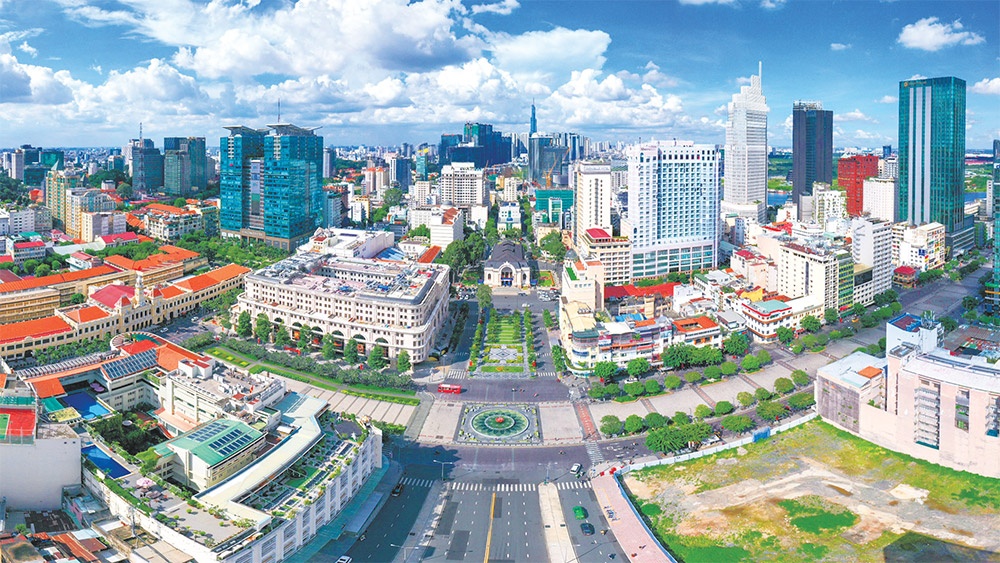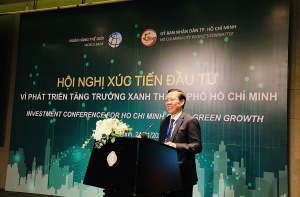Ho Chi Minh City takes a green path
 |
| Roads and bridges are being worked on that can contribute towards a greener development strategy, photo Le Toan |
The city wishes to promote innovation initiatives and multinational cooperation, calling for private investment to gradually transition to a greener and more sustainable economy, it was announced at a green investment promotion conference organised in coordination with the World Bank last week.
Ho Chi Minh City People’s Committee has issued a list of 28 projects seeking investment to promote green growth. Of those, three high-tech manufacturing projects in electronics and semiconductors require more than $178 million. The city is also calling for funding for a data centre project worth over $300 million.
The metropolis also seeks investment for research and development projects in electronics and semiconductors of about $8.7 million, and supporting industrial production projects with high technology of $14.3 million.
Investment is also wanted for a number of projects in Thu Thiem New Urban Area such as a financial, commercial, and residential area costing $500 million; an exhibition, hotel, and trade complex worth $70 million, and a central square and riverbank park with capital of $220 million.
In addition, there are projects to upgrade and expand major routes such as National Highway 13, National Highway 22, Thu Thiem 4 Bridge, Can Gio Bridge, and Ho Chi Minh City-Moc Bai Expressway.
Ho Chi Minh City is also looking for cash for five projects in wastewater treatment, environmental improvement, and urban embellishment.
The latest research results published by the Institute of Environment and Natural Resources under the Ho Chi Minh City National University have showed that the city releases average annual total greenhouse gas emissions of around 60 million tonnes of CO2, mainly from industrial production, traffic, and living activities. At the same time, the city is also facing the negative effects of climate change, environmental pollution, resource shortages and economic crisis.
At the conference, Chairman of Ho Chi Minh City People’s Committee Phan Van Mai, said, “Along with the general trend around the world, Ho Chi Minh City chooses to give top priority to green growth as its future development strategy to achieve economic prosperity and environmental sustainability. We are moving towards a green and carbon-neutral economy, contributing to the goal of limiting global temperature rises.”
He also added that the city had set a target of reducing emissions by 10 per cent by 2030.
Carolyn Turk, World Bank country director for Vietnam, East Asia, and the Pacific, said the goal could only be achieved through the correct strategies.
“The city needs to motivate the private sector to participate in the green transition process. In many other countries, tax incentives are applied to green businesses, but this can be difficult in some countries, especially developing countries,” Turk said.
“Therefore, the World Bank will accompany Ho Chi Minh City in implementing the economic development strategy to reduce emissions and commit to supporting the city in accessing financial resources and attracting foreign resources to reduce carbon emissions.”
Ho Chi Minh City and the World Bank created a joint working group two years ago and have had some results, such as a $650 million investment package for a 10-year programme, an investment scheme to upgrade public assets, and an integrated flood management scheme.
The World Bank is committed to supporting Ho Chi Minh City in accessing financial resources and attracting foreign resources to reduce carbon emissions. According to Turk, the carbon credit market is a good resource, and she hopes that Ho Chi Minh City can sell credits on the voluntary carbon market.
“Innovations are easy to implement, but the costs are high. If Ho Chi Minh City does it and sells them itself, the transaction costs are high. Therefore, the World Bank wants to help it synthesise all carbon credits, creating a large enough volume for international transactions,” Turk explained.
She added that, due to the small scale, the private sector was having difficulty in accessing the world’s voluntary carbon credit market.
The World Bank has appointed Ho Chi Minh City State Financial Investment Company to be the leading unit to coordinate carbon credits in the city.
Flooding alone causes economic damage to the city that can reach up to $250 million per year, a figure that is likely to continuously increase every year.
| Phan Ngoc Anh, director, ALENA Energy Technology Co., Ltd. The actual situation in Ho Chi Minh City now contains many problems needed to be resolved related to traffic, especially environmental pollution emitted from vehicles. To contribute to solving these problems, we would like to propose ideas and goals for developing electric vehicles in Ho Chi Minh City. The goal of our project is to install charging stations for electric vehicle batteries in Ho Chi Minh City, and motorbikes can change batteries without having to be charged. Charging stations use solar power to charge batteries, ensuring the original power source uses 100 per cent clean electricity. We also synthesise all clean electricity data to register and issue renewable energy certificates for rooftop solar power and electricity used for motorbikes. The benefits of this project are minimising environmental pollution, increasing the use of renewable energy, contributing to environmental protection and response to climate changes, and creating a new type of business. For the project to be successful, we do hope that the People’s Committee of Ho Chi Minh City will support procedures such as developing a system plan for battery exchange stations and solar power installation and establishing a steering committee for supporting policies on taxes, fees, and interest rates for businesses consulting in the development of electric vehicles, solar power stations, and other installations. Do Hong Hanh, ceo, Buyo Bioplastics Buyo was established in 2022 in Ho Chi Minh City. We provide solutions for converting organic waste in the agricultural and food processing industries into alternative products for plastic. We aim to solve the global plastic waste problem. The company uses advanced techniques to turn organic waste in agricultural production such as sugarcane bagasse into new materials that are 100 per cent organic and can be replaced for plastic. This can be decomposed in one year instead of 500 years like regular plastic. It is safe for the environment and health, but still meets the features of plastic at a reasonable price. This is a new pioneering technology not only in Vietnam but also worldwide, developed 100 per cent in Vietnam by Buyo’s team of experts and scientists, with the support and advice of Belgium’s AB InBev in cooperation with the Ho Chi Minh City Biotechnology Centre and the Ho Chi Minh City University of Natural Sciences. Currently, Buyo is producing on a trial basis at its factory in Cu Chi district of Ho Chi Minh City, with an output of about 5-10 tonnes per month of soft packaging such as wraps, bags, and hard plastics such as trays, tableware, cups, jars, and bottles. In the near future, we will launch a group of plastic products used in medicine, cosmetics, and foodstuffs. Buyo is also researching to improve production, reducing product costs so that they are not too different from conventional plastic to further enhance competitive advantage. Macrc Forni, lead specialist, Urban Resilience World Bank World Bank and Ho Chi Minh City are coordinating to propose a project has a total expected investment of about $250 million. Of which, $170 million expects to come from the World Bank, $50 million from non-refundable aid from the Dutch government, and the remaining $30 million from counterpart capital from Ho Chi Minh City. The project will be prepared in over the next two years and implemented in 2025-2030. Rapid urbanisation and industrialisation have contributed to increased greenhouse gas emissions and reducing the city’s resilience. Meanwhile, brands in developed countries are facing pressure to reduce their carbon footprints, and are increasingly requiring net-zero emissions commitments. Therefore, their product supply chain also needs to be greened. In that context, a low carbon urban project in Ho Chi Minh City in priority areas has been built over the past 18 months, and has been carried out in the first phase of the joint working group between Ho Chi Minh City and the World Bank, with the aim to help the city reduce carbon emissions at scale through implementing simple and replicable solutions that can be implemented at scale across public and private assets. The project will create a city-managed system to support access to international voluntary carbon markets for both the public and private sectors, contributing to increasing the financial feasibility of solutions to reduce city’s emission. The project focuses on solutions that are simple but can be replicated and implemented on a large scale, and have been proven effective through international experiences. Among those are upgrading to LED street lights, installing rooftop solar power, adding more energy-saving devices, and convert to electric vehicles. |
 | Ho Chi Minh City seeks investors for $6.7 billion green projects Ho Chi Minh City is calling for investments in 28 projects, worth around VND160 trillion (over $6.7 billion), dedicated to green growth objectives. These projects were introduced at a conference on January 24 at Lotte Hotel. |
What the stars mean:
★ Poor ★ ★ Promising ★★★ Good ★★★★ Very good ★★★★★ Exceptional
Related Contents
Latest News
More News
- Global partnerships key to Vietnam’s IFC development (December 26, 2025 | 16:18)
- Vingroup pulls out of bid to invest in North-South high-speed railway (December 26, 2025 | 11:42)
- Strengthening supply chains through trade promotions and customs reform (December 24, 2025 | 14:00)
- PM orders investment model for North–South high-speed rail (December 22, 2025 | 17:43)
- LS Eco Energy to invest in Vietnam rare earth sector (December 22, 2025 | 17:31)
- Government moves to establish International Financial Centre (December 21, 2025 | 21:00)
- Vietnam's IFC to target global investment flows (December 21, 2025 | 18:00)
- Two national hospitals expand capacity with new facilities (December 20, 2025 | 09:00)
- Ha Tinh breaks ground on major Vingroup industrial and energy projects (December 19, 2025 | 18:24)
- EVN launches major power infrastructure projects nationwide (December 19, 2025 | 18:17)

 Tag:
Tag:



















 Mobile Version
Mobile Version